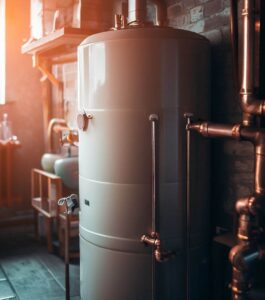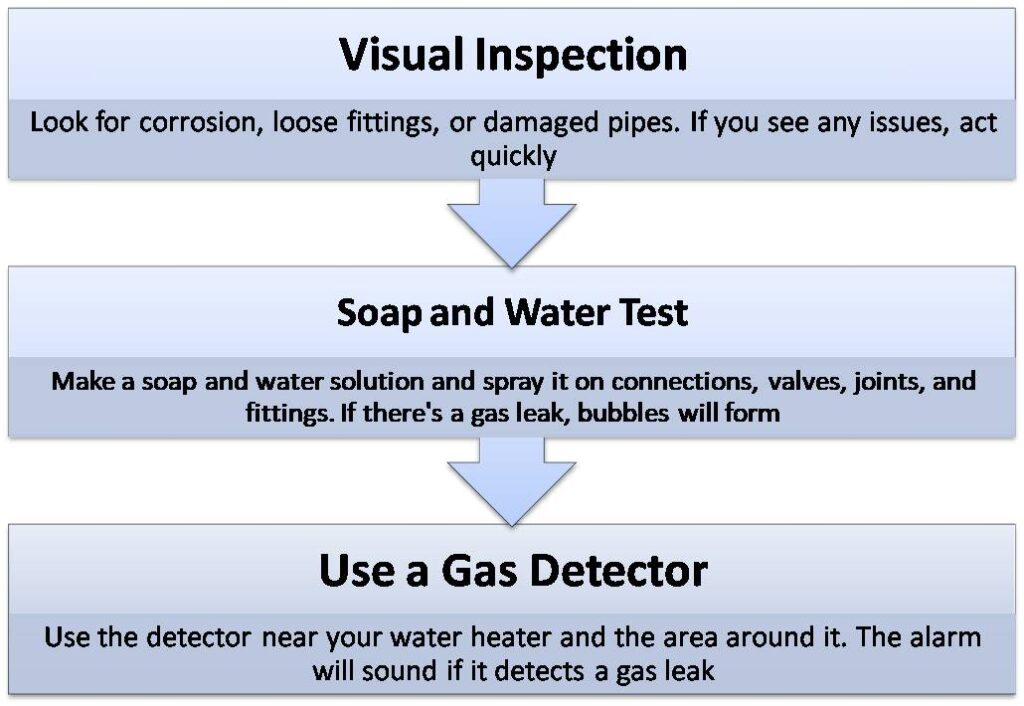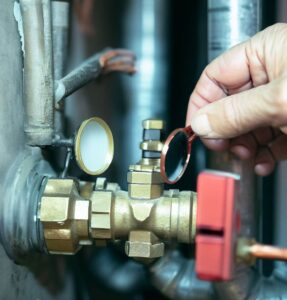Table of Contents
Water heaters are a must in our lives. Ensuring safety is key to avoiding any disasters. Here are tips to keep your water heater safe:
- Check the pressure relief valve. Lift the lever or turn the knob. Hot water should gush out before it stops. If there is no discharge, replace the valve.
- Monitor the temperature. Optimal temp is around 120°F. Lower temps could lead to bacteria growth. Check with the manufacturer for best settings.
- Be aware of carbon monoxide emissions. Gas-fired water heaters can produce this lethal gas. Inspect the venting system and install a CO detector nearby.
An example of why you should regularly inspect your water heater: a family experienced a fire due to a faulty gas water heater. Their pilot light had gone unnoticed. This could’ve been avoided with an inspection.

So, remember: water heater safety—it’s not just about a hot shower, it’s about safety!
Importance of Water Heater Safety
Water heater safety is essential to protect you and your home. Here are some important tips to remember:
- Check the pressure and temperature of your water heater regularly by testing the pressure relief valve. A functional relief valve is a must to prevent an explosion from excessive pressure.
- Precautions against carbon monoxide poisoning are needed too. Gas-fired water heaters produce this dangerous gas, so make sure the area is well ventilated and that there is a working carbon monoxide detector.
- Check for any leaks or damage in the water heater tank. Leaks can cause flooding and damage to your home. Structural damage can result in the tank rupturing or collapsing. Have a qualified plumber inspect and fix any issues.
- Maintain proper clearances around your water heater. Make sure there is enough space for ventilation and access for maintenance. Keep flammable materials away – they could cause a fire.
- Regular maintenance is key to the efficiency and safety of your water heater. Follow the manufacturer’s guidelines.
In conclusion, stay alert to water heater safety measures and address any issues with professional help. Gas leaks are like a surprise party, except the only thing they bring is danger and potential explosions.
Checking for Gas Leaks from Water Heater
Gas leaks can be serious. To stay safe, check for gas leaks regularly. Here’s a 3-step guide:
- Visual Inspection: Look for corrosion, loose fittings, or damaged pipes. If you see any issues, act quickly.
- Soap and Water Test: Make a soap and water solution and spray it on connections, valves, joints, and fittings. If there’s a gas leak, bubbles will form. This test can detect even small leaks.
- Use a Gas Detector: Get a detector specifically designed for natural gas or propane. Follow the instructions and use the detector near your water heater and the area around it. The alarm will sound if it detects a gas leak.
Repeat these steps often to stay safe.

Note: Natural gas is odorless but has an added odorant called mercaptan that smells like rotten eggs. Propane also has a distinct smell. Never use open flames or electricity to check for gas leaks. If you think there’s a leak or have symptoms such as dizziness, nausea, or headaches, leave the area and call emergency services.
In 2018, a gas leak in Colleyville caused an explosion that caused serious damage. This serves as a reminder to prioritize the safety of your water heater.
Inspecting the Pressure Relief Valve of Water Heater
It’s a must to inspect the pressure relief valve regularly for water heater safety. Here are some tips to do it right:
- Check for leaks. Look for any leaky signs or dripping water around the relief valve. This may mean high pressure or a broken valve.
- Test the valve’s function. Lift the lever and see hot water and steam come out. If nothing happens, or it’s weak, it might be clogged or faulty.
- Make sure it’s in the right place. The valve should discharge hot water and steam away from people and combustible items.
- Inspect for rust, corrosion, or damage. Look on the valve body and pipe. These can weaken the pressure relief system.
- Check the pressure rating. It should be between 150-175 psi. Check the manufacturer’s instructions for details.
- Ask a pro if unsure. Get a qualified plumber or inspector if needed.
Remember, ignoring the pressure relief valve can mean danger, like pressure buildup, leaks, or explosions. Regular inspection is key for a safe and efficient water heater.

A Brief Note: Inspecting the pressure relief valve isn’t enough. Other safety steps are also important, such as checking temperature settings, monitoring carbon monoxide, ensuring good ventilation, and clearing flammable materials near the water heater.
Maintaining the Water Heater Tank
It’s time to keep our water heaters in check! When inspecting, look for any visible signs of damage, such as leaks or corrosion. Check the relief valve too, to make sure it’s functioning properly. If any issues arise, call a plumber for repairs!
Additionally, flush the tank annually to prevent mineral deposits from forming. Attach a garden hose to the drain valve and let the water run until it’s clear. Temperature settings should be set to around 120 degrees Fahrenheit for both safety and efficiency. Keep in mind that each water heater may have different requirements, so check the manufacturer’s instructions.
When I was caring for mine, I noticed a small leak near the relief valve discharge pipe. I acted quickly and called a plumber to sort it out. This incident showed me how important it is to inspect and repair water heaters right away. Not only will this keep them running safely, but also extend their service life! So, let’s keep our water heaters well-ventilated and happy.
Ensuring Proper Ventilation for Water Heater
When it comes to your water heater’s ventilation, safety is key! Follow this easy 3-step guide to make sure your heater gets the air it needs:
- Check the location. Place it somewhere with lots of space for air to flow around freely. This reduces heat buildup and harmful gases like carbon monoxide.
- Inspect the venting system. Make sure it’s clear and no blockages are present. Otherwise, air flow will be impeded, leading to dangerous heating processes.
- Install a carbon monoxide detector. As an extra safety measure, put one near your water heater. If dangerous levels of CO are present, you’ll be alerted immediately!
Remember, ventilation is essential. Neglecting it can cause gas leaks, fires, and even poison. Different heaters may need different ventilation, so read the manufacturer’s instructions and consult a qualified plumber if you’re unsure.
Don’t waste time – get your water heater properly ventilated today! It’ll give you peace of mind and keep your family safe. Plus, keep its temperature and pressure in check – no one wants a scalding hot shower or an explosion!
Monitoring Water Temperature and Pressure of Water Heater
Monitoring water temperature and pressure is essential for your water heater’s safety and efficiency. Here’s what to do:
- Check the temperature regularly. Set the thermostat to around 120 degrees Fahrenheit. Use a thermometer to measure the hot water at different faucets. If it’s too high, adjust the thermostat.
- Test the pressure relief valve. Locate it on your water heater. Lift the lever to release water into a bucket. Do this at least once a year to ensure it works properly.
- Inspect for leaks. Check around pipe connections, valves, and fittings. Address any leaks immediately or they can damage your water heater.
- Install an expansion tank. If you have a closed plumbing system or pressure fluctuations, an expansion tank can regulate pressure.
Also, proper ventilation is vital for gas-fired water heaters. Make sure there’s enough combustion air supply in the room. Don’t block or obstruct vents. Consult with a qualified plumber or follow manufacturer’s instructions.
Remember, overheated hot water tanks can explode. Monitor temperature and pressure to prevent this risk. Plus, carbon monoxide leaks can cause ghost sightings. Keep your water heater free from them.
Understanding Carbon Monoxide Safety
Carbon monoxide (CO) safety is key when it comes to water heaters. It’s essential to be aware of the potential dangers and take precautions to ensure the safety of your home and its occupants.
CO is a colorless and odorless gas released by gas-fired water heaters. It’s a byproduct of incomplete combustion and can be lethal, causing carbon monoxide poisoning with serious health issues and death.
To avoid CO hazards, make sure the area of your water heater has proper ventilation. Adequate airflow allows for complete combustion and the safe dissipation of CO. Additionally, having a functioning CO detector near your water heater or nearby offers an early warning if dangerous levels are present.
Regular maintenance and inspections are also necessary for CO safety. A qualified plumber or inspector should check for any leaks, damaged parts, or malfunctioning safety controls. They will also check your flue or venting system is properly installed, providing a way for gases to escape outside.
Know that electric water heaters don’t have a risk of CO emissions since they don’t burn fuel. But, gas-fired water heaters do, so take extra care.
In short, understanding CO safety is important for a safe environment at home. Get necessary precautions like proper ventilation, regular maintenance, and installing CO detectors to prevent potential hazards from gas-fired water heaters.
Maintaining a Safe Working Space for Water Heater
For the wellbeing of your household, a safe working space for water heaters is key. Here are some helpful pointers:
- Get a qualified plumber or inspector to install and inspect your water heater regularly. This will help spot any potential problems and guarantee safe operation.
- Check the pressure relief valve often to ensure it’s functioning properly. This valve releases extra pressure from the tank, preventing explosions.
- Monitor your water heater’s temperature settings. It should be set at an apt level to keep you from scalding while still providing hot water.
- Be conscious of carbon monoxide risks. Gas-fired water heaters can emit this undetectable and dangerous gas, so install proper ventilation and carbon monoxide detectors.
- Keep a clear area around the water heater. Remove any flammable stuff or mess that could cause a fire or impede access to safety devices.
- Inspect the tank for leaks or damage on a regular basis. If you notice any signs, like puddles or corrosion, handle them straight away to stop further damage or hazards.
Plus, here are some further steps to guarantee a safe space:
- Install an expansion control valve and an expansion tank if your area dictates it. These tools help accommodate thermal expansion and stop too much pressure in the water heater.
- Make sure there are clearances as per safety codes between the water heater and combustible stuff like insulation, closets, or storage spaces.
- Check the ventilation for gas-fired water heaters. Make sure there’s enough combustion air and that venting systems aren’t blocked.
By heeding these tips, you can make sure your water heater runs safely and minimizes the danger of explosions, carbon monoxide poisoning, or fires. So, keep warm and safe with these water heater tips – a successful bathroom escape plan doesn’t involve burning your sensitive parts!
Frequently Asked Questions
Q1: How often should I check the pressure and temperature of my water heater?
A1: It is recommended to check the pressure and temperature of your water heater at least once a year. This ensures proper functioning and helps prevent potential hazards.
Q2: How can I ensure the safety of my water heater?
A2: To ensure the safety of your water heater, you should perform regular safety inspections, check for any leaks or damage, maintain proper working space around the heater tank, and keep flammable materials away from it.
Q3: What is the purpose of a pressure relief valve and why is it important?
A3: A pressure relief valve allows excess pressure to escape from the water heater tank, preventing the build-up of dangerous levels of pressure. It is important as it helps prevent explosions or damage to the heater.
Q4: Can a gas water heater release carbon monoxide?
A4: Yes, gas water heaters can produce carbon monoxide, a colorless and odorless gas that can be dangerous if inhaled in high concentrations. It is crucial to ensure proper ventilation and have carbon monoxide detectors installed.
Q5: Is it necessary to hire a professional for water heater inspections?
A5: It is highly recommended to hire a qualified plumber or an inspector experienced in water heater safety inspections. They have the expertise to identify potential hazards and make necessary recommendations for repairs or replacements.
Q6: What are some signs that my water heater may be unsafe?
A6: Signs that your water heater may be unsafe include strange odors, leaks, unusual sounds, or inconsistent hot water. If you notice any of these issues, it is recommended to have your water heater inspected by a professional.
Conclusion
For water heater safety, there are certain steps to take:
- Get a qualified plumber or inspector to do regular safety inspections.
- Check the pressure and temp settings.
- Test the pressure relief valve.
- Ensure proper ventilation and fit carbon monoxide detectors.
- Keep flammable materials far away.
For gas-fired water heaters: Pilot light should be lit and blue. If there are gas leaks or odorless fumes, contact a professional. Good insulation saves energy and prevents heat loss.
Pro Tip: Drain sediment from the water tank regularly (check manufacturer guidelines).
Remember, keeping your water heater safe protects your property and those in the building. Stay informed of relevant codes and regulations about installation and maintenance.
